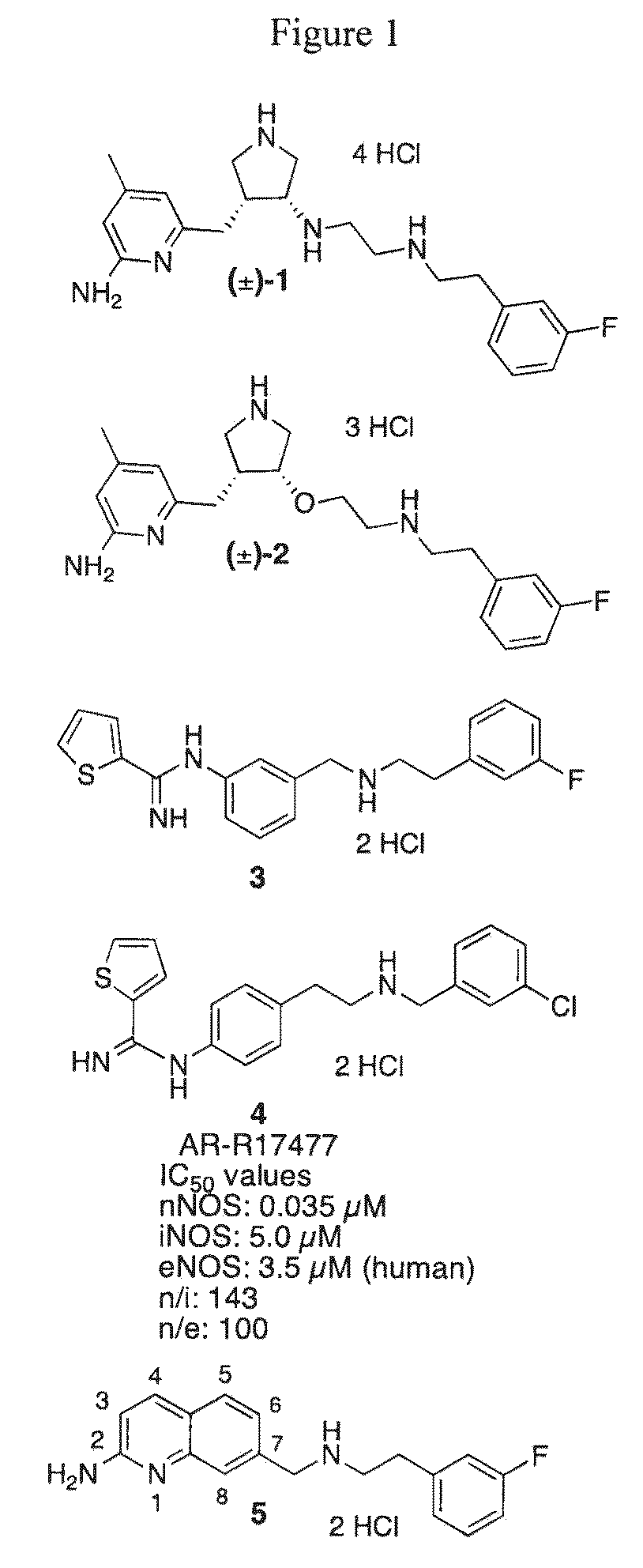2-aminoquinoline-based compounds for potent and selective neuronal nitric oxide synthase inhibition
a technology of neuronal nitric oxide and compound, which is applied in the field of neurodegeneration disorders, can solve the problems of reducing the nitric oxide synthase activity of neurons, affecting the survival rate of neurons, so as to improve the oral bioavailability and blood-brain barrier penetration, and improve the effect of oral bioavailability and/or commercially available starting materials
- Summary
- Abstract
- Description
- Claims
- Application Information
AI Technical Summary
Benefits of technology
Problems solved by technology
Method used
Image
Examples
example 1
[0090]7-Methylquinolin-2(1H)-one (18a) and 5-Methylquinolin-2(1H)-one (18b). Compound 17 (4.26 g, 18.0 mmol) was diluted in chlorobenzene (45 mL) and anhydrous AlCl3 (12.0 g, 5.00 mmol) was added. The mixture was heated to 90° C. for 2 h, upon which the solution became black. The solution was cooled and poured into ice-H2O (300 mL), which was extracted with EtOAc (2×300 mL). The organic phase was washed with H2O (200 mL), and the aqueous layer was extracted with EtOAc (100 mL). The combined organic layers were washed with sat. aq. NaCl (200 mL) and dried over anhydrous sodium sulfate. The orange solution was filtered through Celite and concentrated to afford the mixture of products as a beige solid (2.53 g, 88%) after washing with hexanes and drying. 1H NMR spectra indicated that 18a and 18b were present as a 70:30 mixture (consistent with prior reports), which was used without any further purification.
example 2
[0091]2-Chloro-7-methylquinoline (19a). A mixture of 18a and 18b (2.53 g, 15.9 mmol) was diluted in POCl3 (˜35 mL), and the mixture was heated at reflux for 70 min, before the clear orange solution was cooled to room temperature and poured into ice-H2O (300 mL) in a large beaker. The beaker was immersed in ice and cooled to 0° C. with stirring, and solid NaOH was added until the pH of the mixture was approximately 7. The resultant cloudy suspension was extracted with EtOAc (300 mL) and the organic layers were washed with H2O (100 mL) and sat. aq. NaCl (100 mL). The organic layer was dried over anhydrous sodium sulfate, concentrated, and the residue was purified by flash column chromatography (SiO2), eluting with a gradient of hexanes to 12% ethyl acetate in hexanes to afford orange crystals. Fractional crystallization from hot isopropanol yielded pure 19a (0.850 g, 30%) as light orange iridescent crystals; the analytical data for this compound is identical to prior literature report...
example 3
[0092]2-(Acetamido)-7-methylquinoline (20). Chloride 19a (0.300 g, 1.69 mmol) was diluted with molten anhydrous acetamide (8 g, 135 mmol) and K2CO3 (1.17 g, 8.45 mmol) was added. The mixture was heated in a sand bath, at reflux (˜230° C.) for 17 h. The mixture was cooled, poured into H2O (120 mL) and extracted with EtOAc (4×30 mL). The organic layers were washed with H2O (3×100 mL) and sat. aq. NaCl (50 mL), dried over anhydrous sodium sulfate, and concentrated. Purification of the residue by flash column chromatography (SiO2, 15% EtOAc in CH2Cl2) afforded the desired compound as a white solid (0.265 g, 78%). 1H-NMR chemical shifts for this compound are consistent with those reported in the literature for the 7-isomer. H-NMR (500 MHz; CDCl3): δ 9.89-9.88 (br s, 1 H), 8.40 (d, J=8.9 Hz, 1 H), 8.15 (d, J=9.0 Hz, 1 H), 7.67 (d, J=8.3 Hz, 1 H), 7.58 (d, J=0.6 Hz, 1 H), 7.29 (dd, J=8.3, 1.4 Hz, 1 H), 2.54 (s, 3 H), 2.27 (s, 3 H).
PUM
| Property | Measurement | Unit |
|---|---|---|
| pKa | aaaaa | aaaaa |
| pKa | aaaaa | aaaaa |
| angle | aaaaa | aaaaa |
Abstract
Description
Claims
Application Information
 Login to View More
Login to View More - R&D
- Intellectual Property
- Life Sciences
- Materials
- Tech Scout
- Unparalleled Data Quality
- Higher Quality Content
- 60% Fewer Hallucinations
Browse by: Latest US Patents, China's latest patents, Technical Efficacy Thesaurus, Application Domain, Technology Topic, Popular Technical Reports.
© 2025 PatSnap. All rights reserved.Legal|Privacy policy|Modern Slavery Act Transparency Statement|Sitemap|About US| Contact US: help@patsnap.com



